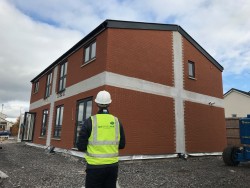Mitch Gee, SPSenvirowall Director, has over 35 years’ experience in the construction industry and a staunch supporter of innovation and offsite construction. The Offsite Hub Blog caught up with him earlier in the year to discuss why the wider building industry is so slow to adapt.
With the aim of boosting housing supply, tackling the national housing shortage, and achieving the Government’s 300,000 new homes a year by the mid-2020s is an ambitious one.
Described as the silver bullet solution to the housing crisis, offsite modular construction should be seen as a viable solution given all of its advantages compared to traditional methods – the benefits of are undeniable. It offers quick construction, consistent quality-controlled assembly in a factory environment, greater volume in repetition while relying less on weather, traditional skills and provides a step-change in productivity and efficiency.
Currently, the internal infrastructures for planning and procurement of offsite modular construction are unfit to meet the housing demands. Not only are there misconceptions surrounding offsite modular, but there are also challenges still left to solve before the wider adoption of this style of construction.
Local Authorities aren’t yet seeing the importance of utilising offsite construction to meet their housing supply targets. Given that offsite is deemed to be at least 20% more expensive than traditional construction and requires significantly more upfront costs, investment and ultimately commitment from the start. This is partly due to the procurement methodology whereby public-bodied money must first go through a framework or a competitive tendering process.
Quantity surveyors should also begin thinking differently to the conventional tendering process by assessing the overall construction costs, without making direct comparisons with traditional methods, while also considering the value of shorter build programmes and less snagging. Added value and enhanced revenue will be quickly realised via early delivery prelim costs by taking a holistic view on a commercial contract.
An additional challenge identified is that offsite manufacturers operate differently to each other in terms of their design and approach, when considering the use of an exterior pre-finished product. While some may complete 90% or more within the factory environment, others offer panelised systems or unfinished volumetric boxes for completion on-site. Complete factory production doesn’t always meet the objectives of fast track construction, and installation of the cladding element on-site may allow for shorter build times and improved aesthetics. By identifying the responsibility for the exterior facade early in the design process, whether this is delivered by the modular provider, client or main contractor, the challenge is easily overcome.
SPSenvirowall understands that the management of risk is always an important consideration. For this reason, we engaged with Building Life Plans (BLP) and Lloyds Register to undertake the Build Offsite Property Assurance Scheme (BOPAS) accreditation, which provides 60-year product and process assurance for RendaClad.
This proprietary façade replaces the need to build a structural masonry outer leaf. The system ensures a fully-ventilated and drained cavity is maintained within the wall structure, meeting the requirements of the NHBC and TRADA. It can be applied to any wall structure, lightweight steel frame or masonry construction. With the application of RendaClad, the high-performance solution reduces overall construction time and costs. The panels, thin coat renders are quicker and more cost-effective than the laying of traditional bricks and application of thick Monocouche renders.
RendaClad can be applied in-factory or on-site, its cost-effective nature ensures enhanced revenue and quick delivery for the developer.
For more information visit: www.spsenvirowall.co.uk









